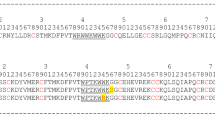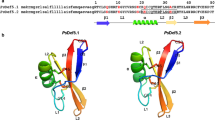Abstract
Peptide fragments that exhibit antimicrobial activity in vitro have been shown to be produced by cleavage from the hydrophilic region near the N terminus of various vicilin proteins in plant seeds. Three peptide sequences identified in the hydrophilic region of vicilin seed proteins of Macadamia integrifolia and Theobroma cacao were predicted to exhibit antimicrobial activity based on sequence similarity to antimicrobial peptides that had been previously purified from macadamia kernels. Histidine-tagged versions of the putative antimicrobial peptides were expressed in Escherichia coli, purified, and demonstrated to have in vitro antimicrobial activity. There are many vicilin sequences in the growing plant genome sequence databases, and this expression method provides a high-throughput process for functionally testing the potential of internal peptide fragments of vicilins as novel antimicrobial molecules.




Similar content being viewed by others
References
Broekaert WF, Cammue BPA, DeBolle MFC, Thevissen K, De Samblanx GW, Osborn RW. Antimicrobial peptides from plants. Crit Rev Plant Sci. 1997;16:297–323.
Cammue BPA, De Bolle MFC, Terras FRG, Proost P, van Damme J, Rees SB, et al. (1992) Isolation and characterization of a novel class of plant antimicrobial peptides from Mirabilis jalapa seeds. J Biol Chem. 1992;67:2228–33.
Chung RP-T, Neumann GM, Polya GM. Purification and characterization of basic proteins with in vitro antifungal activity from seeds of cotton, Gossypium hirsutum. Plant Sci. 1997;127:1–16.
Harrison SJ, McManus AM, Marcus JP, Goulter KC, Green JL, Nielsen KJ, et al. Purification and characterization of a plant antimicrobial peptide expressed in Escherichia coli. Protein Expr Purif. 1999;15:171–7.
Hirel PH, Schmitter JM, Dessen P, Fayat G, Blanquet S. Extent of N-terminal methionine excision from Escherichia coli proteins is governed by the side-chain of the penultimate amino acid. Proc Natl Acad Sci U S A. 1989;86:8247–51.
Manners JM. Hidden weapons of microbial destruction in plant genomes. Genome Biol. 2007;8:225.
Manners JM, Penninckx IAMA, Vermaere K, Kazan K, Brown RL, Morgan A, et al. The promoter of the plant defensin gene PDF1.2 from Arabidopsis is systemically activated by fungal pathogens and responds to methyl jasmonate but not to salicylic acid. Plant Mol Biol. 1998;38:1071–80.
Marcus JP, Goulter KC, Green JL, Harrison SJ, Manners JM. Purification, characterisation and cDNA cloning of an antimicrobial peptide from Macadamia integrifolia. Eur J Biochem. 1997;244:743–9.
Marcus JP, Green JL, Goulter KC, Manners JM. A family of antimicrobial peptides is produced by processing of a 7S globulin protein in Macadamia integrifolia kernels. Plant J. 1999;19:699–710.
Moura FT, Oliveira AS, Macedo LLP, Vianna ALBR, Andrade LBS, Martins-Miranda AS, et al. Effects of a chitin-binding vicilin from Enterolobium contortisiliquum seeds on bean bruchid pests (Callosobruchus maculates and Zabrotes subfasciatus) and phytopthogenic fungi (Fusarium solani and Colletotrichum lindemuthianum). J Agric Food Chem. 2007;55:260–6.
Saitoh H, Kiba A, Nishihara M, Yamamura S, Suzuki K, Terauchi R. Production of antimicrobial defensin in Nicotiana benthamiana with potato virus X vector. Mol Plant Microb Interact. 2001;14:111–5.
Schenk PM, Baumann S, Mattes R, SteinbiB HH. Improved high-level expression system for eukaryotic genes in Escherichia coli using T7 RNA polymerase and rare ArgtRNAs. Biotechniques. 1995;19:196–200.
Silverstein KAT, Moskal WA Jr, Wu HC, Underwood BA, Graham MA, Town CD, et al. Small cysteine-rich peptides resembling antimicrobial peptides have been under predicted in plants. Plant J. 2007;51:262–80.
Stephens C, Harrison SJ, Kazan K, Smith FWN, Goulter KC, Maclean DJ, et al. Altered fungal sensitivity to a plant antimicrobial peptide through over-expression of yeast cDNAs. Curr Genet. 2005a;47:194–201.
Stephens C, Kazan K, Goulter KC, Maclean DJ, Manners JM. The mode of action of the plant antimicrobial peptide, MiAMP1 differs from that of its structural homologue, the yeast killer toxin WmKT. FEMS Microbial Letts. 2005b;243:205–10.
Tailor RH, Aclan DP, Attenborough S, Cammue BPA, Evans IJ, Osborn RW, et al. A novel family of small cysteine-rich antimicrobial peptides from seed of Impatiens balsamina is derived from a single precursor protein. J Biol Chem. 1997;272:24480–7.
Thomma BPHJ, Cammue BPA, Thevissen K. Plant defensins. Planta. 2002;216:193–202.
von Heijne G. A new method for predicting signal sequence cleavage sites. Nucleic Acids Res. 1986;14:4683–90.
Wang X, Bunkers GJ, Walters MR, Thoma RS. Purification and characterisation of three antifungal proteins from cheesewood (Malva parviflora). Biochem Biophys Res Commun. 2002;282:1224–8.
Yamada K, Shimada T, Kondo M, Nishimura M, Hara-Nishimura I. Multiple functional proteins are produced by cleaving asn–gln bonds of a single precursor by vacuolar processing enzyme. J Biol Chem. 1999;274:2563–70.
Acknowledgment
We are grateful to J. Green, A. M. Plume, A. Rusu, and N. Willemsen for technical assistance.
Author information
Authors and Affiliations
Corresponding author
Rights and permissions
About this article
Cite this article
Marcus, J.P., Goulter, K.C. & Manners, J.M. Peptide Fragments From Plant Vicilins Expressed in Escherichia Coli Exhibit Antimicrobial Activity In Vitro . Plant Mol Biol Rep 26, 75–87 (2008). https://doi.org/10.1007/s11105-008-0024-9
Published:
Issue Date:
DOI: https://doi.org/10.1007/s11105-008-0024-9




